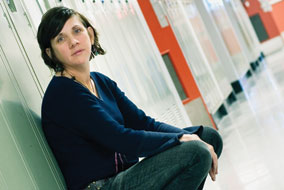
Jo-Anne Dillabough handed out disposable cameras and asked students to document their neighbourhood - photo by Martin Dee UBC Reports | Vol. 52 | No. 10 | Oct. 5, 2006
“Ginas,” “Thugs” and “Gangstas”
Two-Year Study of Vancouver, Toronto Youth Subcultures
By Lorraine Chan
Everyone at this inner-city Toronto high school knows them as the “Gangstas” for their taste in baggy trousers, rap music, chains and tattoos -- distinct from “Ginos,” who prefer tight clothes, dance music and hair gel.
Over on Vancouver’s Eastside, a similar but different scene plays out at a high school where one of the main groups is sometimes called the “Hardcore Asians.” Despite their name, the members nonetheless allow some non-Asians to join their ranks and have a reputation for defending kids against racist bullying.
“These kids are creating these identities and groups as a way to survive,” says Assoc. Prof. Jo-Anne Dillabough in the Faculty of Education.
She observes that subcultures are present in all economic classes, but the conflict and tensions are more substantially felt among youth living in lower-income neighborhoods.
“Some girls feel pressure to take on an identity of toughness to accrue power because they feel they don’t have any. In some cases, if a young person takes on a ‘gangsta’ persona, it may be for reasons concerning the need for race and class protection.”
A sociologist, Dillabough studies the impact of globalization on youth subcultures. Her recently published paper, “Ginas,” “Thugs,” and “Gangstas”: Young People’s Struggles to Become Somebody in Working-Class Urban Canada, details the 2001-03 ethnographic findings of her research with Grade 9 and 10 students in Vancouver and Toronto.
Dillabough has won further funding from Canada’s Social Sciences and Humanities Research Council to expand her study to include inner-city schools in Melbourne, Australia and Hackney, London’s poorest borough.
“The more educators can respect and understand why these youth subcultures and social rituals exist, the more they’re likely to make school relevant and meaningful to young people’s lives.”
Dillabough says when she interviewed the Toronto students, few were certain they would see high school graduation. “That’s worrisome because a few generations ago, in an industrial labour market, these young people would have very likely found labouring jobs or would have had more secure employment options.”
She says there’s an urgent need for post-industrial societies like Canada to provide viable education and support to young people who are buffeted by the forces of a globalized economy that favours the middle class, particularly knowledge-based workers.
By gaining an inside view of these subcultures, Dillabough says teachers and policy makers can tackle the streaming that occurs now where certain students or even entire schools get labelled low- or non-achieving. As well, she says it’s vital to address the forms of peer conflict students face in urban inner-city schools around flash points of race, class, sexuality, gender and global change.
“One way to reduce tensions among youth subcultures is by providing students a means to incorporate their lived experiences in our strategies to engage them,” she says. “Even more importantly, provincial and federal governments need to respond in concrete ways to the rising poverty among young people.”
As part of the study, Dillabough invites students to express themselves and to develop critical analysis through visual projects that include: media and film analysis; photography; self-portraits; and future employment images and time-lines.
“This provides a forum for young people to address topics like citizenship, immigration, security, identity and belonging,” explains Dillabough, “and to stop blaming themselves as failures when we’re really looking at systemic failure.”
In one assignment, she handed out disposable cameras so students could document their neighborhood -- a Toronto housing project.
“Some young people said they couldn’t see themselves living anywhere else because at least they wouldn’t feel out of place like they might in a middle-class neighbourhood. Others talked about the shame they felt about living in public projects, or the fact that police would never answer an emergency call.”
She says 20 years of cuts to educational and social programs in Ontario – with similar belt tightening in B.C. over the past 10 years – have taken their toll. There are fewer dollars going toward family support, social assistance and programs such as subsidized housing. Many school and community programs to support youth have disappeared, while their families are finding it more difficult to rise above cycles of poverty and social despair.
“One in five families live below the poverty line in large Canadian cities,” she says. “Immigrant and asylum-seeking youth are often the ones who face the most difficult economic challenges.”
As well, Dillabough says there’s a strong move worldwide to focus on education standards through literacy tests and school assessments. “With so many cuts to the support structure of schools, many marginalized, low-income students can’t compete equally with their middle class peers.” |
